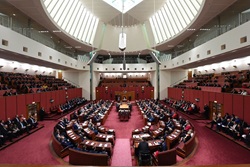
Auspic
Posted 21/07/2022 by Michael Sloane
Following the 21 May 2022 federal election, the newly appointed Prime Minister, Anthony Albanese, stated that the new Parliament would first meet on 26 July 2022—106 days after the previous Parliament was dissolved. The opening of a new Parliament proceeds according to constitutional requirements, House of Representatives and Senate standing orders and resolutions, and long-standing ceremonial practices. This Flagpost article outlines and contextualises these aspects prior to the new parliament opening later this month.
Picking the date
Section 5 of the Constitution provides the legal basis for summoning the Parliament to meet following a general election. Under this provision the Governor-General, acting on the advice of the Government, determines the opening date of the new Parliament, which must not be later than 30 days after the last day appointed for the return of the writs. For the 2022 federal election, the writs were required to be returned on or before 28 June 2022.
Welcome to country ceremony
In a 2001 report, the House Procedures Committee recommended including a welcome to country ceremony in the opening of a new Parliament; however, this did not occur until 2008. In June 2010, the requirement that ‘local Indigenous people be invited conduct a ceremony of welcome prior to Members assembling in the House of Representatives’ was included in House standing orders (SO 4(a)), with the Senate also declaring its support.
Opening of the Parliament
Once members and senators have gathered in their respective chambers at the time appointed in the Governor-General’s proclamation, two deputies appointed by the Governor-General (usually justices of the High Court) attend the Senate chamber, request the attendance of members, and declare open the Parliament.
The opening of the Parliament in the Senate reflects British custom, where the opening of Parliament occurs in the House of Lords. However, the appropriateness of this practice has been questioned on the grounds that it erroneously equates the Senate with the House of Lords and does not afford equal status to the House of Representatives. The practice of appointing justices of the High Court as deputies of the Governor-General has also been criticised for involving members of the judiciary in non-judicial functions.
Swearing in of members and senators
Following the formal opening of the Parliament in the Senate chamber, members return to the House of Representatives to be sworn in by the Governor-General’s deputy. In the Senate, senators representing the territories are always sworn in as part of the opening proceedings as their terms coincide with those of the House of Representatives. Excluding double dissolutions, it is only necessary to swear in senators representing the states if the opening occurs after the changeover in Senate terms on 1 July. When this happens on 26 July, it will be only the fourth time this has occurred since Federation (the three other times being 1910, 1913 and 2019).
Election of presiding officers
The House of Representatives must then choose a member to serve as Speaker. The Senate must also choose a senator to serve as President if that office is vacant—for example, if the opening occurs after the changeover in Senate terms on 1 July, there has been a double dissolution, or the previous President has resigned. If multiple candidates are nominated for either office, the respective clerk conducts a secret ballot. The newly selected presiding officers are then presented to the Governor-General.
Governor-General’s opening speech
The Governor-General then attends the Senate, generally at 3 pm, to deliver a speech declaring ‘the cause of his calling the Parliament together’. In practice this involves outlining the newly commissioned government’s program, a practice originating in the UK Parliament. Before delivering the speech, the Governor-General requests the attendance of members of the House. The Usher of the Black Rod, in a ceremony also imitating long-standing UK parliamentary practice, knocks on the door of the House chamber three times before being granted entry to deliver the Governor-General’s request.
In its 2001 report, the House Procedure committee noted criticisms of the Governor-General’s involvement in setting out the government’s political program, but concluded the practice demonstrates that the Governor-General is impartial and acts on the advice of the government of the day. While the speech generally proceeds without incident, in February 1976 the Whitlam-led Opposition refused to attend Governor-General John Kerr’s speech, following Kerr’s dismissal of Whitlam as Prime Minister the previous November.
Formal business and address in reply debates
House standing orders require that some formal business be conducted prior to the Governor-General’s speech (Senate standing orders merely allow this to occur). In keeping with UK Parliament tradition, these provisions are intended to express independence from the sovereign. In practice, the Senate does not conduct any formal business and in the House, a ‘privilege bill’ is generally read a first time, but not proceeded with. The House Procedure Committee has recommended reforming this convention twice (in 2001 and 2008) on the grounds that its expression of independence is undermined if, as is usual practice, the Prime Minister introduces the Bill.
Once the Governor-General’s opening speech has been reported in each chamber, an ‘address in reply’ motion is proposed, allowing senators and members to participate in a wide ranging debate on the government’s program for the new Parliament. The address in reply debate also provides an opportunity for newly elected members and senators to give their first speeches.